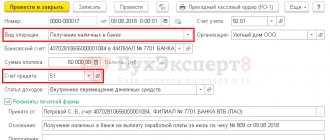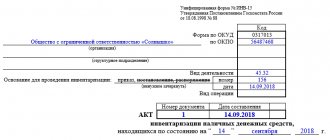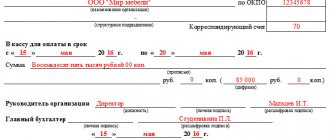Accounting for cash in the cash register - a minimum of theory
The cash register account is an account with code 50. This account records information about money in the company's cash register. This money is called cash, in common parlance – NAL. The entire accounting section of the cash desk can be described in literally a few key terms:
- Cash limit at the cash desk
- Restriction on the maximum amount of settlements with counterparties at the cash desk
- Two main primary cash register documents
- Special report on the cash register.
- A special document intended for issuing wages.
Cash limit
The cash register can store an amount of money every day that does not exceed a certain limit. The limit or limitation of the amount is determined by the bank, in agreement with the head of the enterprise. The limit amount is the amount of money needed by the company to pay for small business expenses, issuing travel allowances, paying wages, etc. The amount of the limits can be revised due to the growing needs of the company.
Organizations, not individual entrepreneurs, must deposit excess cash into a bank account. To do this, if the amounts are large, enterprises use collection services, which come and collect the excess at the end of the day. At the end of the month, the collection company issues our company the amounts for the services provided.
The only case when the cash desk is allowed to have amounts in excess of the limit is on paydays. And then, there is a limit on the number of days - from 3 to 5. The amount of unpaid wages is marked in the accounting as deposited and the money is handed over to the bank.
Limitation of cash payments
First, let's remember who the counterparties are - these are the market participants with whom our company interacts. Participants can be organizations, individual entrepreneurs and individuals. They all interact with each other and carry out mutual settlements in cash, i.e. through the cash register.
When interaction occurs between organizations and individuals, there are no restrictions.
Between an organization and other organizations, between an organization and an individual entrepreneur, there is a limit of 100,000 rubles. within the framework of one contract. Those. You can only pay or receive money in an amount not exceeding 100,000 rubles. under one contract. If the contract amount is larger, then the remaining payments will have to be made through a current account. Or draw up several contracts that differ from each other. Coming up with new, slightly different agreements is done so that regulatory authorities do not consider them made specifically to circumvent the 100,000 ruble limit.
Concept of cash in the cash register
Definition 1
Cash on hand is the totality of paper money and coins that are available in an organization at a certain point in time.
Despite the fact that recently there has been an increase in non-cash turnover of funds and the turnover of electronic money, enterprises still use cash to carry out business activities.
This is due to the fact that it is not always possible to quickly solve the economic needs of an enterprise through non-cash payments, or it is necessary to accept payment from customers in cash.
Cash accounting at the cash registers of enterprises is strictly regulated at the legislative level and contains many norms, documentation rules and restrictions.
Primary documents for accounting cash at the cash desk
The essence of the cash desk section is mutual settlements with counterparties, employees, as well as the issuance of money to accountable persons to pay for the needs of the enterprise itself. The most basic primary documents in cash accounting are:
- Receipt cash order (PKO)
- Expenditure cash order (RKO)
- Payroll or Payroll
The purpose of PKO and RKO is to register the receipt or issuance of money at the cash register. These documents must not have any corrections or blots. If something needs to be corrected, a new document is issued.
In the work of a cashier, in addition to creating PKO and RKO at the cash desk, there is one more action performed at the end of the day. This action will create and print a special report called “Cash Book”.
The “Cash Book” report is a special type of register that collects all cash register movements during the day: all PKOs and cash registers. The cash book shows the balance in the cash register at the beginning of the day, all receipts at the expense of the cash register, expenses at the expense of the cash register and the balance at the end of the day.
The document “Payment or Payroll” is a document more for a payroll clerk. For the cash register (i.e. for the cashier), a printed form of this document is used to issue cash for wages. In the printed form “settlement and payroll”, the employee signs for the money received. At the end of the day, the cashier sums up all amounts paid and makes one general cash settlement for the total amount. The cashier pins the printed cash register form to the printed form “Payment or Payroll”
Examples of primary documents for cash management
Procedure for conducting operations
The receipt of cash into the organization is formalized by an incoming cash order (form KO-1), and the issuance of money - by an outgoing order (form KO-2). Each incoming and outgoing order is recorded in the order register (form KO-3) and in the cash book (form KO-4). Individual entrepreneurs have the right not to keep a book.
The maximum possible amount of cash in the cash register is called the cash limit. It is calculated by the organization independently, based on the daily volumes of cash receipts and cash disbursements.
Individual entrepreneurs and legal entities belonging to small businesses may not set a cash limit by writing this down in their accounting policies.
What is cash discipline?
Compliance with cash discipline comes down to compliance with the rules established by the following documents:
- Directive of the Bank of the Russian Federation dated March 11, 2014 No. 3210-U, which defines the rules for conducting cash transactions for legal entities and individual entrepreneurs. The latest version of the instruction, which came into force on November 30, 2020, introduced a number of changes.
Read more about this document in the article “Nuances of the regulations on the procedure for conducting cash transactions” .
- Directive of the Central Bank of the Russian Federation dated October 7, 2013 No. 3073-U, which contains the conditions for cash payments.
- Law of the Russian Federation dated May 22, 2003 No. 54-FZ, establishing the rules for the use of cash register systems.
- Law of the Russian Federation dated July 3, 2016 No. 290-FZ or the law on online cash registers, which introduced significant changes to the rules of Law No. 54-FZ.
Read more about Law No. 290-FZ and the consequences of its entry into force in the materials:
- “Who should switch to online cash registers from July 1, 2019?”;
- “Latest changes in 54-FZ “On the use of cash register equipment””.
Regarding the operating cash desk, the basic rules are as follows:
- A person is appointed to perform the functions of a cashier, with whom an agreement on full financial responsibility must be concluded. An exception would be situations when the cash register is run by the head of a legal entity or individual entrepreneur, working alone.
- Money and cash documents are stored in conditions that ensure their safety.
- Operations carried out at the cash desk are documented in the prescribed form in compliance with a certain procedure for filling them out. Documents are completed directly upon completion of the transaction, and for the posting of cash proceeds received outside the operating cash desk - daily at the end of the working day. Cash discipline in 2020–2021 for individual entrepreneurs who keep simplified records of their transactions allows for the possibility of not completing cash register documents.
Read more about the types of cash transactions in the article “The concept and types of cash transactions (legal regulation)” .
- If cash proceeds are received at the operating cash desk, then a cash register must be present. The issuance of a cash receipt upon receipt of cash proceeds is mandatory (Article 5 of Law No. 54-FZ).
- Money accepted by the cashier is checked for authenticity. A certain procedure for checking their quantity and quality during acceptance and issuance is observed, named in the instruction of the Central Bank of the Russian Federation dated October 5, 2020 No. 5587-U, valid from November 30, 2020:
- Cash proceeds received by the operating cash desk should be spent only for certain purposes: payment of wages, settlements with suppliers and customers, issuance on account. Individual entrepreneurs can take money for personal needs.
Is it possible to spend from the cash register (bypassing the current account) the balance of the advance unused by the accountable, see here.
- The maximum amount of cash payments between legal entities, between individual entrepreneurs, between legal entities and individual entrepreneurs is limited to 100,000 rubles. under one contract. At the same time, settlements with individuals are not limited, and individual entrepreneurs have the right to take any amounts from the cash register for personal needs.
Read more about the limit on payments between legal entities here .
- Issuance on account is carried out by order of the manager or on the application of the accountable person endorsed by him. To report on amounts issued, the number of working days specified in the employer’s local regulations is provided from the expiration date for which the money was issued (including travel allowances). Unspent amounts must be returned to the cashier or will be withheld from the salary of the accountable person (Article 137 of the Labor Code of the Russian Federation).
- A limit is set on the balance of money in the cash register at the end of the working day. The procedure for calculating it is chosen by the company or individual entrepreneur independently from two methods proposed by the Bank of the Russian Federation Directive No. 3210-U. The excess must be deposited in the bank. An excess balance is allowed only on paydays (no more than 5 working days). Cash discipline in 2020-2021 for LLCs related to small-scale enterprises and individual entrepreneurs suggests that these individuals may not set this limit. For separate divisions, it is established either by the head office (if the division does not have its own current account) or independently (if the division has its own current account).
Read about determining the cash balance limit in this material.
Examples of calculating the cash balance limit at the cash desk from ConsultantPlus 5.1. An example of calculating the cash register limit taking into account the volume of receipts. Cash revenue of Rassvet LLC from the sale of goods for the billing period from 09/01/2020 to 11/30/2020 (64 working days) amounted to RUB 2,385,648. Proceeds are surrendered daily (once a day). To calculate the cash balance limit in the cash register, taking into account the volume of receipts, use the formula. For all examples of calculating the cash limit and samples of documents drawn up for this, see K+. Trial access is available for free.
- Transactions with cash currency can be carried out through the cash desk. Most often they are associated with the issuance of money for foreign business trips and the delivery and receipt of currency at the bank. In some cases, settlements with residents may occur (Article 9 of the Law of the Russian Federation of December 10, 2003 No. 173-FZ).
Read more about currency transactions in the article “Currency transactions: concept, types, classifications” .
Legislative regulation of cash circulation at enterprises
At the legislative level, the circulation of cash in organizations is regulated by regulations of the Central Bank of the Russian Federation.
In particular, the Directive of the Bank of Russia “On Cash Payments” contains rules for business entities on the types of settlements between entities.
Too lazy to read?
Ask a question to the experts and get an answer within 15 minutes!
Ask a Question
Note 1
The Bank of Russia Directive “On the procedure for conducting cash transactions by legal entities and the simplified procedure for conducting cash transactions by individual entrepreneurs and small businesses” will support the rules and regulations for carrying out cash transactions.
This document states:
- identification of business entities that are subject to this regulatory act;
- provision on mandatory cash limit;
- the procedure for documenting cash payments through the enterprise's cash desk;
- other provisions governing the accounting of certain aspects of cash on hand.
There are also other provisions regarding the circulation of cash at the cash desk of organizations.







